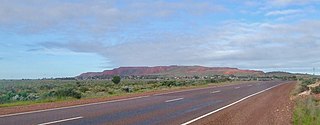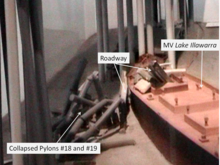
Coke is a grey, hard, and porous coal-based fuel with a high carbon content and few impurities, made by heating coal or oil in the absence of air—a destructive distillation process. It is an important industrial product, used mainly in iron ore smelting, but also as a fuel in stoves and forges when air pollution is a concern.

Steelmaking is the process of producing steel from iron ore and/or scrap. In steelmaking, impurities such as nitrogen, silicon, phosphorus, sulfur and excess carbon are removed from the sourced iron, and alloying elements such as manganese, nickel, chromium, carbon and vanadium are added to produce different grades of steel.

Whyalla is a city in South Australia. It was founded as "Hummocks Hill", and was known by that name until 1916. It is the fourth most populous city in the Australian state of South Australia after Adelaide, Mount Gambier and Gawler and along with Port Pirie and Port Augusta is one of the three towns to make up the Iron Triangle. As of June 2018, Whyalla had an urban population of 21,742, having declined at an average annual rate of -0.75% year-over-year over the preceding five years. It is a seaport located on the east coast of the Eyre Peninsula and is known as the "Steel City" due to its integrated steelworks and shipbuilding heritage. The port of Whyalla has been exporting iron ore since 1903.

A blast furnace is a type of metallurgical furnace used for smelting to produce industrial metals, generally pig iron, but also others such as lead or copper. Blast refers to the combustion air being supplied above atmospheric pressure.

The Eyre Peninsula is a triangular peninsula in South Australia. It is bounded by the Spencer Gulf on the east, the Great Australian Bight on the west, and the Gawler Ranges to the north.

Iron Knob is a town in the Australian state of South Australia on the Eyre Peninsula immediately south of the Eyre Highway. At the 2006 census, Iron Knob and the surrounding area had a population of 199. The town obtained its name from its proximity to large deposits of iron ore, most notably Iron Monarch which outcropped prominently from the relatively flat, surrounding landscape.

Direct reduced iron (DRI), also called sponge iron, is produced from the direct reduction of iron ore into iron by a reducing gas which either contains elemental carbon or hydrogen. When hydrogen is used as the reducing gas there are no greenhouse gases produced. Many ores are suitable for direct reduction.

Blast furnace gas (BFG) is a by-product of blast furnaces that is generated when the iron ore is reduced with coke to metallic iron. It has a very low heating value, about 93 BTU/cubic foot (3.5 MJ/m3), because it consists of about 51 vol% nitrogen and 22 vol% carbon dioxide, which are not flammable. The rest amounts to around 22 vol% carbon monoxide, which has a fairly low heating value already and 5 vol% hydrogen. Per ton of steel produced via the blast furnace route, 2.5 to 3.5 tons of blast furnace gas is produced. It is commonly used as a fuel within the steel works, but it can be used in boilers and power plants equipped to burn it. It may be combined with natural gas or coke oven gas before combustion or a flame support with richer gas or oil is provided to sustain combustion. Particulate matter is removed so that it can be burned more cleanly. Blast furnace gas is sometimes flared without generating heat or electricity.
Arrium was an Australian mining and materials company, employing nearly 10,000 workers, that went into voluntary administration in 2016 with debts of more than $2 billion. In 2017 it was acquired by British-owned Liberty House Group.
Stewarts & Lloyds was a steel tube manufacturer with its headquarters in Glasgow at 41 Oswald Street. The company was created in 1903 by the amalgamation of two of the largest iron and steel makers in Britain: A. & J. Stewart & Menzies, Coatbridge, North Lanarkshire, Scotland; and Lloyd & Lloyd, Birmingham, England.
The BHP Whyalla DH class were a class of diesel locomotives built by Walkers Limited, Maryborough for the BHP's Whyalla Steelworks between 1962 and 1968.

BHP Shipping was an Australian ship transport and shipbuilding arm of BHP.
The Corex Process is a smelting reduction process created by Primetals as a more environmentally friendly alternative to the blast furnace. Presently, the majority of steel production is through the blast furnace which has to rely on coking coal. That is coal which has been cooked in order to remove impurities so that it is superior to coal. The blast furnace requires a sinter plant in order to prepare the iron ore for reduction. Unlike the blast furnace, smelting reduction processes are typical smaller and use coal and oxygen directly to reduce iron ore into a usable product. Smelting reduction processes come in two basic varieties, two-stage or single-stage. In a single-stage system the iron ore is both reduced and melted in the same container. In a two-stage process, like Corex, the ore is reduced in one shaft and melted and purified in another. Plants using the Corex process have been put use in areas such as South Africa, India, and China. First COREX process was installed in 1988 at South Africa.
The Middleback Range is a mountain range on the eastern side of Eyre Peninsula in South Australia. The Middleback Range has been a source of iron ore for over a century, particularly to feed the Whyalla Steelworks. Mines in the region were first developed by BHP from the 1890s and are now owned and operated by Liberty House Group.
SIMEC Group Ltd is a British international energy and natural resources business focused on resources, sustainable power, infrastructure, and commodities trading. In 2016 it had an annual turnover of almost USD2.5 billion and net assets of USD350 million. It is part of the Gupta Family Group ("GFG") Alliance, owned by members of the Gupta family, which had a combined turnover of more than USD13 billion and combined net assets of more than USD2.3 billion. Its activities span renewable energy generation, mining, shipping, and commodities trading.

The Lithgow Blast Furnace is a heritage-listed former blast furnace and now park and visitor attraction at Inch Street, Lithgow, City of Lithgow, New South Wales, Australia. It was built from 1906 to 1907 by William Sandford Limited. It is also known as Eskbank Ironworks Blast Furnace site; Industrial Archaeological Site. The property is owned by Lithgow City Council. It was added to the New South Wales State Heritage Register on 2 April 1999.
The BHP Whyalla Tramway is a 1067 mm gauge heavy-haul railway, 112 kilometres long, on the Eyre Peninsula in South Australia. It runs from haematite mines at Iron Monarch, Iron Baron and Iron Duke in the Middleback Range, about 50 kilometres west of Whyalla, to company steelworks at the coastal city of Whyalla. Opened in 1901, it was built by, and until 2000 operated by, BHP. As of 2021 it was owned by Liberty Steel Group and operated on its behalf by rail operator One Rail Australia, which was sold in 2022 to Aurizon.

Charles Henry Hoskins (1851-1926) was an Australian industrialist, who was significant in the development of the iron and steel industry in Australia.

Sir Cecil Harold Hoskins (1889–1971) was an Australian industrialist associated with the iron and steel industry. He is notable mainly for the establishment of the steel industry at Port Kembla, the company Australian Iron & Steel, and its subsequent merger with BHP in 1935. He was also on the board of the Australian Mutual Provident Society for many years and was its chairman from 1947 to 1962. He is less well known for his involvement in centre-right political organisations and the scouting movement, and his interest in landscape gardens.



















